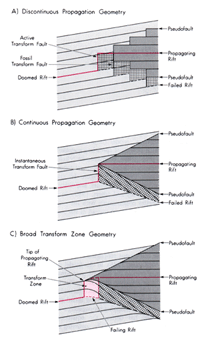
Galapagos
Earth's Fastest Spreading Ridge
Hawaii Institute of Geophysics and Planetology
Galapagos
Galapagos is now considered one of the type-examples of hotspot-ridge interaction. However, in the early years of plate tectonics it was generally thought (except by Tuzo Wilson, Jason Morgan and their disciples) that this interpretation was demonstrably wrong, with two influential groups insisting that non-hotspot models were required for this area. The key to understanding Galapagos tectonic evolution was the recognition that small ridge axis jumps toward the hotspot had occurred, producing complicated magnetic anomalies and asymmetric lithospheric accretion. My dissertation work, guided by Jason Morgan, showed that this simple modification to plate tectonic theory could resolve the seemingly compelling geometric arguments against the Cocos and Carnegie aseismic ridges being Galapagos hotspot tracks, and further that if Galapagos were a hotspot near Fernandina, fixed with respect to the Hawaii hotspot, there should be aseismic ridges on the Cocos and Nazca plates with the observed Cocos and Carnegie ridge geometry, both aseismic ridges forming when the hotspot was ridge-centered, but only the Carnegie ridge since the plate boundary migrated north of the hotspot. The Farallon plate split apart along the Grijalva scarp, probably in response to tensional stress caused by slab pull in different directions at the Mid-America and Peru-Chile trenches. This break-up allowed more orthogonal subduction of independent Cocos and Nazca plates beginning shortly after 25 Ma. The original Cocos-Nazca ridge trended E-NE, but soon reorganized into N-S spreading segments. The subsequent evolution involved substantial northward ridge migration and ridge jumps, mostly toward the Galapagos hotspot. Recent ridge jumps have occurred in systematic patterns that led to the propagating rift hypothesis.
The Galapagos 95.5°W propagator, propagating west away from the hotspot, was the first active propagating rift discovered (Hey and Vogt, 1975; 1977). In addition to routine geophysical techniques, an OBS array and extensive dredging, this area has been surveyed with GLORIA, SeaMARC II, SeaBeam, Deep-Tow, and ALVIN, and has become the type-example propagating rift system. The middle right figure is a color-shaded relief map of SeaBeam bathymetry from Hey et al. (1986). The NW-SE trending structures between the propagating and failing ridges are incompatible with previous plate tectonic theory but are a predictable consequence of the rift propagation hypothesis if propagation is continuous. The geometry of the propagating rift and sheared zone of transferred lithosphere are most closely matched by the broad “non-transform” zone geometry in model C at lower right, whereas rift failure has been discontinuous as in model A. Outside of the area bounded by the outer pseudofault, the transform zone, and the failed rift, classic plate tectonic geometry is still valid.
Almost all of the new rifts propagate “downhill” away from the hotspot, probably driven by gravity sliding stresses due to the shallow lithosphere. The origin of many propagation sequences appears to involve discrete southward jumps forming new segments near the hotspot. The observed petrological and geochemical variations are interpreted as consistent with mantle plume and propagating rift effects.
As it turned out, this work provided an explanation for one of the most famous data sets in marine geophysics, the Juan de Fuca magnetic anomaly pattern.
Publications
- Hey, R.N., K.S. Deffeyes, G.L. Johnson, and A. Lowrie, The Galapagos triple junction and plate motions in the East Pacific, Nature, 237, 20-22, 1972.
- Hey, R.N., Tectonic evolution of the Cocos-Nazca rise, Ph.D. Thesis, Department of Geological and Geophysical Sciences, Princeton University, 169, 1975.
- Hey, R.N. and P.R. Vogt, Rise axis jumps and sub-axial flow near the Galapagos hotspot, Interdisciplinary Symposium l0: Mid-Ocean Ridges, Oceanic Trenches and Geodynamics, Grenoble IUGG, 89, 1975.
- Johnson, G.L., P.R. Vogt, R.N. Hey, J. Campsie, and A. Lowrie, Morphology and structure of the Galapagos rise, Marine Geophysical Research, 21, 81-120, 1976.
- Hey, R.N. and P.R. Vogt, Spreading center jumps and sub-axial asthenosphere flow near the Galapagos hotspot, Tectonophysics, 37, 41-52, 1977.
- Hey, R.N., G.L. Johnson, and A. Lowrie, Recent plate motions in the Galapagos area, Geol. Soc. Am. Bull., 88, 1385-1403, 1977.
- Hey, R.N., Tectonic evolution of the Cocos-Nazca spreading center, Geol. Soc. Am. Bull., 88, 1404-1420, 1977.
- Hey, R.N., Evidence for spreading center jumps from fine-scale bathymetry and magnetic anomalies near the Galapagos Islands, Geology, 7, 504-506, 1979.
- Hey, R.N., F.K. Duennebier, and W.J. Morgan, Propagating rifts on mid-ocean ridges, J. Geophys. Res., 85, 3647-3658, 1980.
- Wilson, D.S. and R.N. Hey, The Galapagos axial magnetic anomaly: Evidence for the Emperor event within the Brunhes and for a two-layer magnetic source, Geophys. Res. Lett., 8, 167-188, 1981.
- Sinton, J.M., D.S. Wilson, D.M. Christie, R.N. Hey, and J.R. Delaney, Petrologic consequences of rift propagation on oceanic spreading ridges, Earth Planet. Sci. Lett., 62, 193-207, 1983.
- Searle, R.C. and R.N. Hey, GLORIA observations of the propagating rift at 95.5°;W on the Cocos-Nazca spreading center, J. Geophys. Res., 88, 6433-6447, 1983.
- Hey, R.N., High-technology investigations of rift propagation and plate tectonics, Proceedings OCEAN's 83, Inst. of Electrical and Electronics Engineers/Marine Technology Society, 2, 791-796, 1983.
- Hey, R.N., M.C. Kleinrock, S.P. Miller, T.M. Atwater, and R.C. Searle, Sea Beam/Deep-Tow investigation of an active oceanic propagating rift system, J. Geophys. Res., 91, 3369-3393, 1986.
- Miller, S.P. and R.N. Hey, 3-D magnetic modelling of a propagating rift, Galapagos 95.5°;W, J. Geophys. Res., 91, 3395-3406, 1986.
- Schubert, G. and R.N. Hey, Mantle viscosity beneath the Galapagos 95.5°;W propagating rift, Geophys. Res. Lett., 13, 329-332, 1986.
- Miller, S.P. and R.N. Hey, A magnetic investigation of a tectonic problem: The propagating rift, Galapagos 95°; 30'W, J. Geodynamics, 5, 1-24, 1986.
- Hey, R.N., J.M. Sinton, and F.K. Duennebier, Propagating rifts and spreading centers, in Decade of North American Geology: The Eastern Pacific Ocean and Hawaii, Geological Society of America, 161-176, 1989.
- Kleinrock, M.C. and R.N. Hey, Detailed tectonics near the tip of the Galapagos 95.5°W propagator: How the lithosphere tears and a spreading axis develops, J. Geophys. Res., 94, 13801-13838, 1989.
- Kleinrock, M.C., R.C. Searle, and R.N. Hey, Tectonics of the failing spreading system associated with the 95.5°W Galapagos propagator, J. Geophys. Res., 94, 13839-13858, 1989.
- Kleinrock, M.C. and R.N. Hey, Migrating transform zone and lithospheric transfer at the Galapagos 95.5°W propagator, J. Geophys. Res., 94, 13859-13878, 1989.
- Hey, R.N., J.M. Sinton, M.C. Kleinrock, R.N. Yonover, K.C. Macdonald, S.P. Miller, R.C. Searle, D.M. Christie, T.M. Atwater, N.H. Sleep, H.P. Johnson, and C.A. Neal, 1992, ALVIN investigation of an active propagating rift system, Galapagos 95.5°W, Marine Geophys. Res., 14, 207-226.
- Kleinrock, M.C., R.N. Hey, and A.E. Theberge, Practical geological comparison of some seafloor survey instruments, Geophys. Res. Lett., 19, 1407-1410, 1992.
- Wilson, D.S. and R.N. Hey, History of rift propagation and magnetization intensity for the Cocos-Nazca spreading center, J. Geophys. Res., 100, 10041-10056, 1995.
- Hey, R.N., Propagating Rifts and Microplates, in Encyclopedia of Ocean Sciences, eds. J.H. Steele, S.A.Thorpe, and K.K. Turekian, Academic Press, London, Volume 4, 2300-2308, 2001.
- Hey, R.N., Propagating Rifts and Microplates at Mid-Ocean Ridges, in Encyclopedia of Geology, eds. R.C. Selley, R. Cocks and I. Plimer, Academic Press, London, 396-405, 2004.
- Hey, R., Galapagos Tectonics and Evolution, Eos Trans. AGU, 91, Fall Meet. Suppl., V52A-01, 2010.
- Hey, R., Seafloor Spreading, in Encyclopedia of Solid Earth Geophysics, ed. H. Gupta, Springer, Dordrecht, ISBN 978-90-481-8701-0, 1055-1059, 2011.
- Hey, R.N., Propagating Rifts and Microplates at Mid-Ocean Ridges, www.sciencedirect.com/science/article/pii/B978012409548903027X, in Elsevier’s Science Direct online Reference Module in Earth Systems and Environmental Sciences, ed. S. Elias, ISBN: 978-0-12-409548-9, 2013.
- Hey, R.N., Tectonics: Propagating Rifts and Microplates at Mid-Ocean Ridges, www.sciencedirect.com/science/article/pii/B978012409548903027X, in Elsevier’s Science Direct online Reference Module in Earth Systems and Environmental Sciences, ed. S. Elias, ISBN: 978-0-12-409548-9, 2015.
Oceanographic Expeditions
- 1970 May–June: Pacific-Cocos-Nazca triple junction survey, Panama-Panama, Princeton University/U.S. Navy, chief scientist K.S. Deffeyes, USNS DE STEIGUER.
- ** 1979 March–May: Investigations of propagating rifts west of the Galapagos Islands, Acapulco-Santa Cruz, Galapagos, Hawaii Institute of Geophysics, chief scientist R.N. Hey, R/V KANA KEOKI.
- ** 1979 May: Galapagos Islands rock sampling cruise, Santa Cruz-Santa Cruz, Galapagos, Hawaii Institute of Geophysics/Darwin Research Station, chief scientist R.N. Hey, Barco SAN JUAN.
- ** 1979 May–June: Investigations of propagating rifts east of the Galapagos Islands, Puerto San Jose, Guatemala-Santa Cruz, Galapagos, Hawaii Institute of Geophysics, chief scientist R.N. Hey, R/V KANA KEOKI.
- ** 1982 September–October: Sea Beam/Deep-Tow investigation of the Galapagos 95.5°W propagating rift system, Panama-Manzanillo-San Diego, Scripps Institution of Oceanography, chief scientist R.N. Hey, R/V THOMAS WASHINGTON.
- *1985 January: SeaMARC II investigation of the Galapagos 95.5°W propagator, Galapagos-Galapagos, Hawaii Institute of Geophysics, chief scientist F.K. Duennebier, R/V MOANA WAVE.
- **1985 April–May: ALVIN/AII investigation of the Galapagos 95.5°W propagating rift system, Puntarenas, Costa Rica-Acapulco, Scripps Institution of Oceanography/Woods Hole Oceanographic Institution, chief scientist R.N. Hey, R/V ATLANTIS II, DSRV ALVIN.
- ** Chief Scientist
- * Co-Chief Scientist
Students involved in this research
- M. Kleinrock
- D. Christie
- P. Milholland
- R. Yonover
- D. Wilson




